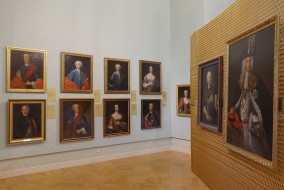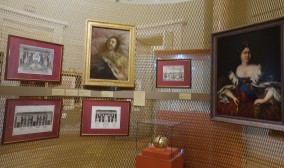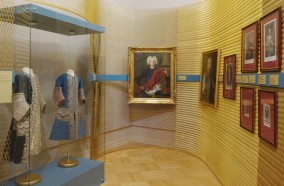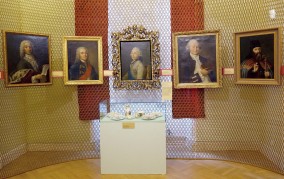Exhibition «The Empire After Peter the Great: From Catherine I to Elizabeth Petrovna»
This exhibition, unique in its scale, covers the period from the death of Peter the Great to the accession to the throne of his daughter Elizabeth Petrovna (1725–1742).
The main events of the internal Russian life in the time of struggle for Peter the Great’s legacy include Peter the Great’s death, the accession of Catherine I with the decisive influence of Alexander Menshikov, the short reign of the infant Peter II, the intrigues of the Dolgoruky princes and the betrothal of the young emperor to a princess of that family, the call to the throne of the Duchess of Courland Anna Ioannovna, the attempt to limit the monarchy by the Conditions, the Age of Biron, the strengthening of the Guard and, finally, the accession to power of Peter’s favourite daughter Elizabeth.
All these court events were accompanied by significant historical decisions such as the establishment of the Order of Alexander Nevsky, the release of Peter the Great’s first wife Evdokia Lopukhina from monastic captivity, and the attempt to return the capital back to Moscow from St Petersburg.
This period is also famous for the strengthening of Russia’s position in the international arena: Savva Raguzinsky’s mission to China and the Treaty of Peace (1728), the mission to Persia, diplomatic victory over England and Denmark, victorious battles with the Crimean Khan.
It was during this period that the establishment of the Academy of Sciences and Arts was completed. This period also saw the achievements of Mikhail Lomonosov and expeditions of Vitus Bering to Kamchatka.
In this period the first general plan of St Petersburg was created. The best Russian architects worked on the construction of the new capital. It was when the great Francesco Bartolomeo Rastrelli began his work. The Russian Museum houses one of the most famous sculptural monuments – a bronze statue of Empress Anna Ioannovna with a little black boy, created by the architect’s father, the outstanding sculptor Carlo Bartolomeo Rastrelli.
The exhibition will be held in the grand rooms of St Michael’s Castle. It is based on the vast and rich collection of the Russian Museum, the largest museum of national art. The exhibition will feature more than 400 (!) works of all kinds and genres. First of all, it is a unique portrait gallery of historical and artistic value, including Ivan Nikitin’s masterpiece Portrait of Peter the Great on His Death Bed.
The Russian Museum has an extremely rich collection of engravings (over a hundred thousand sheets). It is not often that engravings are displayed as extensively as at this exhibition: 91 objects are to be shown: portraits, view engravings, maps, expedition sketches, coronation celebrations, illuminations, and designs for triumphal arches.
A voluminous section of the exhibition is planned to be dedicated to church art, most of the samples in this section will be shown for the first time ever: Gospel books in richly decorated bindings with silver overlays, rare icons, altar crosses, gift holders, embroidery, unique vestments – the contribution “from the Generous Right Hand of the Pious Empress Anna Ioannovna” (1735). Almost all of the above is kept in the closed armored storerooms of the Russian Museum.
The exhibition will be supplemented by handwritten and printed archival historical documents, architectural drawings, sketches of rarities obtained in Siberian and Kamchatka expeditions, which were destroyed by the fire at the Kunstkamera in 1747.
It is also planned to have a section of “historicism” to include works by masters of the 19th and 20th centuries, depicting important persons and events of that time (paintings by Vasily Surikov, Valentin Serov and others): jesters at the court of Anna Ioannovna, the Ice House, the Secret Chancellery, hunts of Peter II, Anna Ioannovna and Elizabeth Petrovna.
Among the contributors to the exhibition are the State Hermitage Museum, the State Historical Museum, the Moscow Kremlin Museums, the Tretyakov Gallery, the Museum of the History of St Petersburg, the Peterhof State Museum and Reserve, the Pavlovsk State Museum, the Arkhangelskoye State Museum and Reserve, the Military Historical Museum of Artillery, Engineers and Signal Corps of the Russian Ministry of Defense, the Institute of Russian Literature of the Russian Academy of Sciences, the Samara Regional Art Museum – a total of 21 museum institutions. The unique objects loaned from these museums include the crown of Catherine I (Moscow Kremlin), which became a model of imperial crowns in Russia.
The exhibition is held in St Michael’s Castle until September 23, 2024.
General Sponsor VTB Bank
tags cloud
- #opening_of_a_branch
- #lecture
- #exhibition
- #virtual_exhibition
- #virtual_tour
- #online_exhibition
- #мультимедийная_выставка
- #poster_exhibition
- #online_event
- #masterclass
- #contest
- #занятие
- #festival
- #video_conference
- #round_table
- #conference
- #seminar
- #дошкольники
- #школьники
- #студенты
- #семья
- #серебряный_возраст
- #инклюзия
- #multimedia
- #Business_meeting_of_virtual_brances
- #The_Multimedia_Centre
- #Drammatika
- #деньмузеевВФРМ
- #ночьмузеевВФРМ
- #RussianMuseum130
- #RussianMuseum125
- #RussianMuseum120
- #RMcatalogues
- #Библионочь
- #книгиГРМ2019
- #игрыРМ
- #фильмыРМ
- #ночьискусствВФРМ
- #Artefact
- #100years_restorationRM
- #Peter_I_350
- #Antarctica200
- #folk_art
- #profession_restorer
- #RM_anniversary
- #SPb_anniversary
- #80летПобеды



